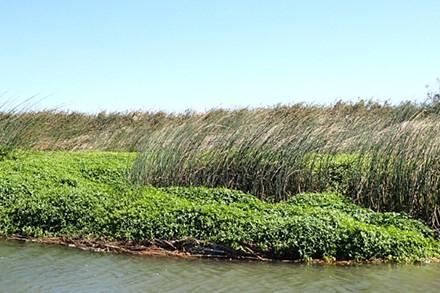Invasive Pest Plant Defies Genetic Limitations

Alligator weed clogs a creek. (Brenda Grewell, D5103-1)
An aquatic invasive weed more at home in warmer climates is making its unwelcome presence felt in the waters of California’s Sacramento-San Joaquin River Delta, near San Francisco.
Alligator weed (Alternanthera philoxeroides), a native of South America, is a perennial plant that grows in a dense tangled mass. As a result, it can choke waterways, increase flooding potential, displace native plants, and disrupt aquatic habitats. Alligator weed can also grow on land, making it a threat to most riparian agro-ecosystems.
According to scientists from the Agricultural Research Service (ARS), the plant has somehow been able to alter its genetic makeup in a way that allows it to thrive in cooler climates.
“At first, we thought this was due to global warming,” said David Horvath, plant physiologist with the ARS Edward T. Schafer Agricultural Research Center in Fargo, ND. “However, we found gene expression differences between northern and southern populations of alligator weed. Thus, there are likely genetic and epigenetic differences associated with the northward range expansion.”
Epigenetics are temporary modifications of the proteins that “stick” to the DNA and can change how genes are turned on or off.
“Alligator weed is known to have exceptionally plastic growth responses (the ability to adapt to environmental changes),” Horvath said. “We hope to soon have a sequence of the alligator weed genome and should be able to use it to leverage our ability to study both genetic and epigenetic differences as it adapts to new environments.”
In the meantime, other ARS researchers are taking an interdisciplinary approach to advance basic knowledge of aquatic weed biology and ecology, and to find potential biological control agents. They were particularly interested in understanding the failure of beetles that have successfully controlled alligator weed in the South. The alligator weed flea beetle (Agasicles hygrophila), cannot survive in temperatures below 9 C (48 F).
“The beetles failed to establish in the northern regions of the weeds’ range,” said Angelica Reddy, entomologist with the ARS Invasive Species and Pollinator Health unit in Albany, CA. “We collected and compared the cold tolerance of domestic (North America) and foreign (South America) A. hygrophila populations and found that [beetles] from Argentina were significantly more cold-tolerant. Armed with this new information, we will make additional attempts to release and establish a cold-tolerant biotype of A. hygrophila in California.”
Other ways to control invasive plants include using chemical herbicides and physical removal, but there are drawbacks to each. Chemical control is difficult, expensive, and creates concerns about environmental health. Manual or mechanical weed removal is labor-intensive, costly, and provides only temporary control.
The ARS team is dedicated to mitigating the alligator weed infestation because the region is a crucial California water resource. The Delta supplies fresh water to about 27 million people and irrigates millions of acres of farmland that contribute about $32 billion to the agriculture industry.
Despite those challenges, alligator weed presents scientists with some intriguing prospects, Horvath said.
“Alligator weed has many survival skills and seems able to grow, adapt, thrive, and maintain its phenomenal growth rates in many different environments,” he said. “I think we have a lot to learn from alligator weed that could help us adapt crops to not only survive, but continue to thrive in a climate with increasing extreme weather events.” – by Scott Elliott, ARS Office of Communications

